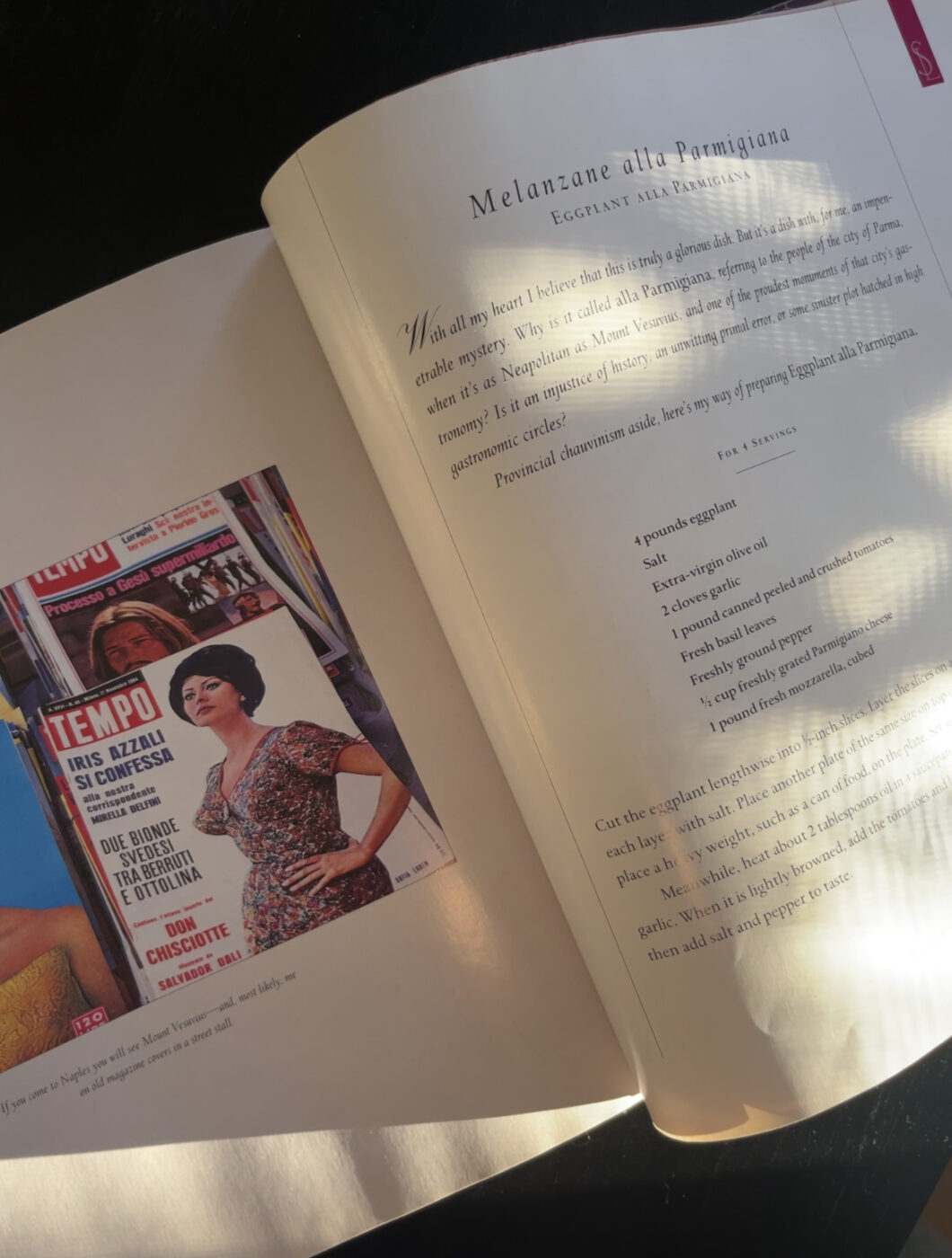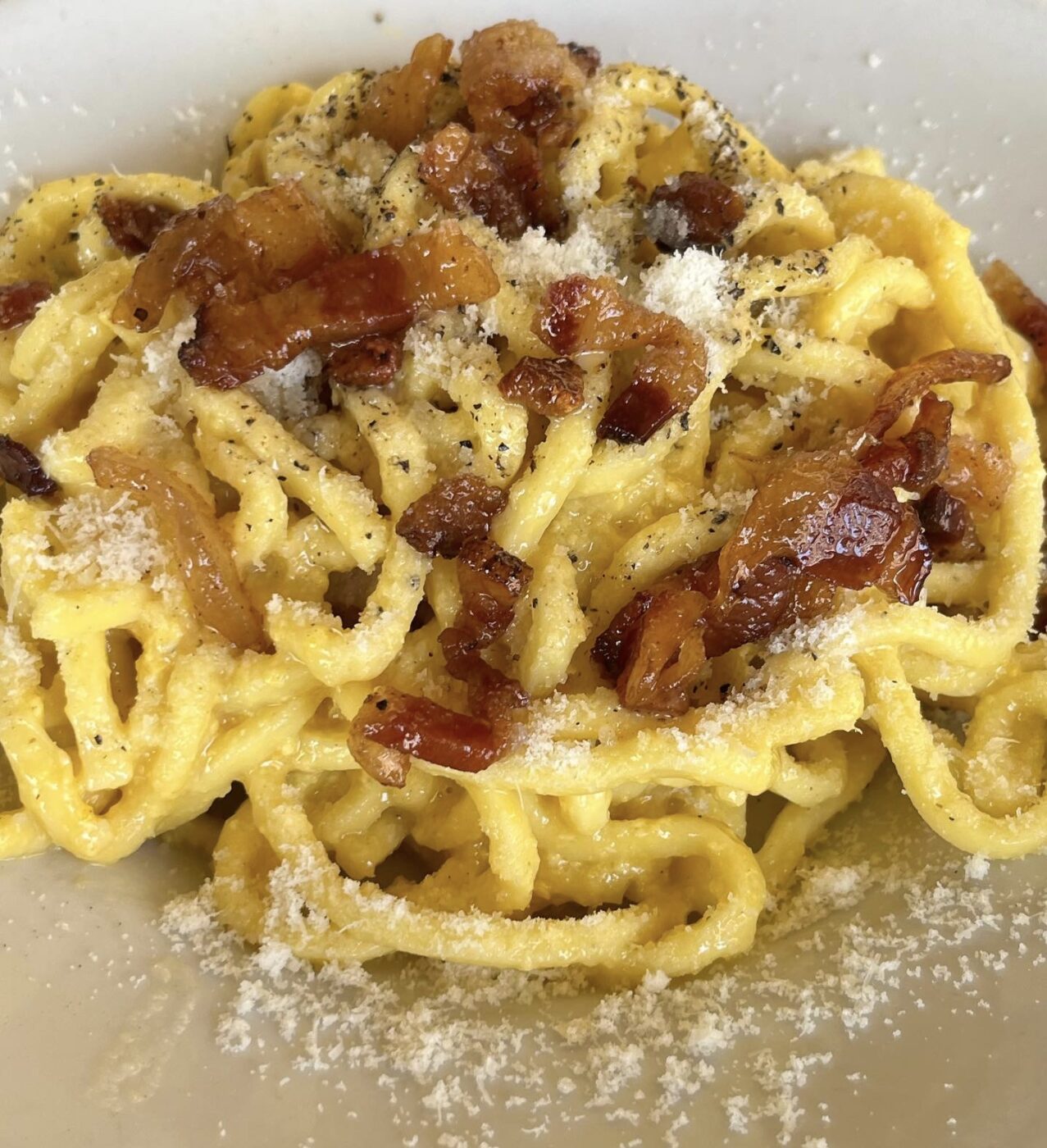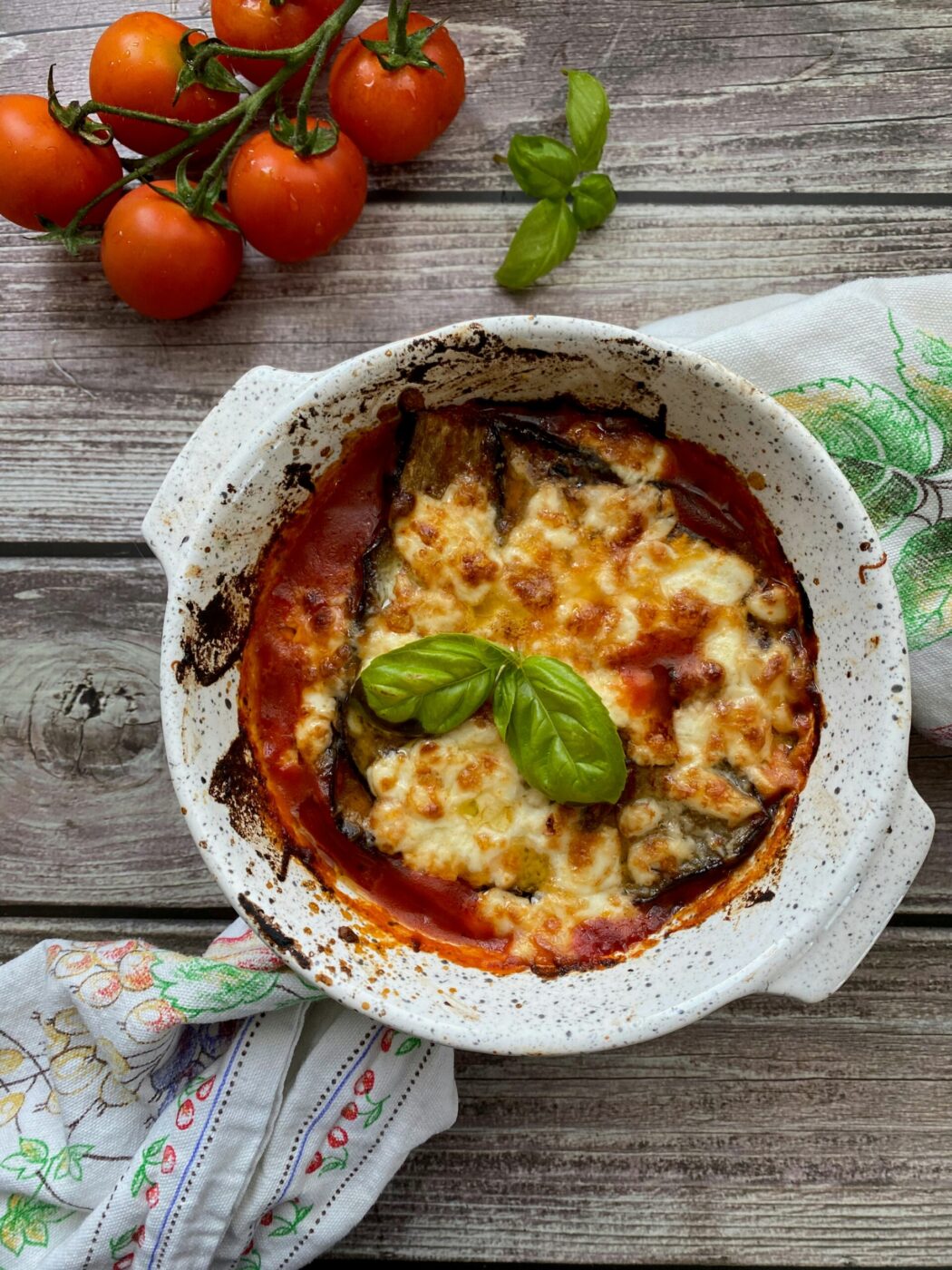It’s a Sunday in Rome, and I’m tucked away in my apartment, thumbing through Sophia Loren’s Recipes and Memories as one of her films plays softly in the background. The air is rich with the fragrance of garlic sizzling on the stove, mingling with the sweet, earthy scent of tomatoes and tender beef slow-cooking into a deep, velvety ragù–a sauce that warms the soul as much as it does the room.
To celebrate her 90th birthday, I’m cooking through Sophia’s cookbook, putting some recipes in conversation with a few of her iconic films–a fitting tribute to a woman whose love for her country and its flavors has become as timeless as her legacy on screen.
Much like her presence on screen, Sophia’s approach to cooking feels deeply intuitive, guided by memory and a sense of joy rather than any rigid instructions. Her recipes are never laid out in precise steps, but read like she’s jotting down a note for an old friend: a handful of fresh herbs, a splash of wine, a swirl of olive oil–her words flow with grace and spontaneity, the same way she moves on a movie set.
Sophia’s foray into writing cookbooks blossomed during a particularly tumultuous period in her life. In the late 1960s, while pregnant in Geneva, she adhered to strict medical advice to avoid stress and physical exertion, having previously suffered two miscarriages. To pass the long days in isolation, she turned to one of her great loves: cooking. Drawing from her memories of childhood in Naples, her travels, and her time spent with famous chefs around the world, she fell even more in love with experimenting in the kitchen.
Encouraged by her friends, Sophia gathered her notes and began working on what would eventually become her first beloved cookbook: In the Kitchen With Love, published in Italian under In Cucina con Amore in 1971 and then in English in 1972. Between the traditional Italian recipes, Sophia peppers in personal anecdotes, offering readers an intimate look into her life and her kitchen. “I met this spaghetti (with bay leaves) at a friend’s house when he gave a dinner to celebrate my Oscar in 1961 for Two Women. Instead of offering me a victor’s laurel crown, he said he would much rather offer the laurel (known as bay leaves in the kitchen) at the table. I must say his idea couldn’t have been better, and I insisted on having the recipe as well.” Then came her second cookbook in 1998, Recipes and Memories, filled with even deeper reflections. With a heavy emphasis on “memories”, she weaves together stories of her travels, time spent on set, and meals that marked important moments in her life.
Sophia’s range of dishes, almost entirely Italian, don’t succumb to the frivolity usually associated with celebrity cookbooks. So, to honor both her films and her recipes, here are five of her most iconic cinematic works paired with five of her beloved dishes—each one, except for Ieri, oggi, domani and penne alla puttanesca, linked by her unforgettable anecdotes.
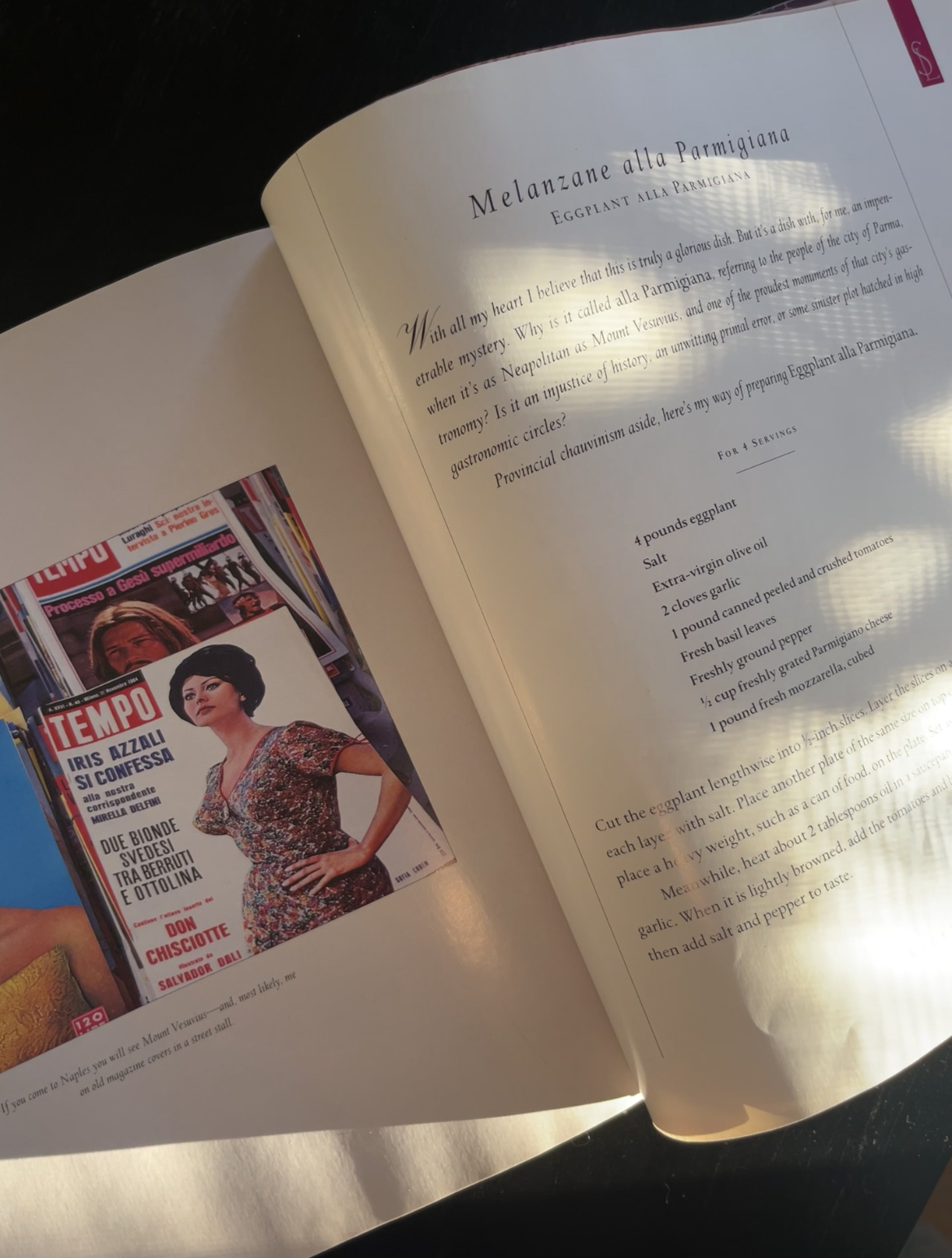
Sophia Loren's Cookbook
La Ciociara (Two Women) & Bucatini alla Carbonara
Sophia Loren earned an Academy Award for Best Actress in 1962 for her role in La Ciociara (1960), Two Women in English, which made her the first actor to win for a non-English language performance. Set during World War II, the movie follows Italian widow Cesira (Loren) as she flees Rome with her daughter, escaping the city as it comes under fire from Allied forces. They find refuge in a quaint village and are drawn to the charismatic Michele (Jean-Paul Belmondo), but their lives are shattered by a tragic event that forces them to confront its profound consequences. The film is dark, dramatic, and beautifully poetic.
They filmed in Ciociaria, a mountainous region south of Rome and north of Naples. Nearby was a small, all-male community of charcoal workers, who kindly prepared maccheroni alla carbonara for the entire cast and crew. The maccheroni they used were strozzapreti: homemade, long, thick strands of pasta with no hole through the center–making them different from bucatini, which Sophia calls for. Both the film’s director, Vittorio De Sica, and Sophia asked for seconds, and the following day, she huddled close to the men at the fire, eager to learn and to take notes on their recipe.
According to Sophia, her recipe stays true to how the men prepared it. She shares that, every time she enjoys the dish, it brings back a wave of nostalgia for those people and places. The authenticity of her version may certainly raise some eyebrows, particularly among Romans, who would shudder at the thought of using cream, or bacon for that matter, in their carbonara. Nonetheless, true to my word, I followed the recipe exactly, opting for Pecorino Romano over parmesan and guanciale over pancetta or bacon. The parsley (another eyebrow raiser) and cream are subtle, and the resulting pasta turns out unctuous and full of flavor. While I’m a sucker for the traditional version, I genuinely enjoyed this one–especially how the silky sauce clings to the bucatini, filling its crevices perfectly.
Sophia Loren’s Bucatini alla Carbonara
Serves 6
INGREDIENTS
- 1 tablespoon olive oil
- 2 tablespoons unsalted butter
- 4 ounces pancetta, bacon, or guanciale (preferred), diced
- Generous pinch of minced Italian parsley
- 5 or 6 egg yolks
- 2 tablespoons light cream
- 3 tablespoons freshly grated Pecorino Romano or Parmigiano Reggiano cheese, plus additional for serving
- 1 1/4 pounds bucatini (or substitute with thick spaghetti or penne if unavailable)
PREPARATION
In a large pan, heat the olive oil and butter over medium heat. Add the diced pork of your choice and the minced parsley to the pan. Sauté until well browned. In a bowl, beat together the egg yolks, light cream, and freshly grated cheese until well combined. Set aside. Meanwhile, cook the bucatini in a large pot of salted boiling water until just al dente. Drain the pasta well. Immediately transfer the drained pasta to a serving dish. Working quickly, pour the guanciale mixture over the pasta, followed by the egg mixture. Toss quickly to coat the strands with the sauce. The heat from the pasta will cook the eggs. Serve immediately with a healthy sprinkling of freshly ground pepper over it (which some food scholars maintain represents a dusting of carbon powder). Pass additional cheese at the table, as you will need a generous shower of Pecorino Romano as a final touch.
Notes:
Although commonly believed that American GIs introduced the essential ingredients of bacon and eggs to Roman cooks, it’s likely that carbonara was already a traditional dish, and the GIs simply provided fresh ingredients.
If bucatini is not available, spaghetti or penne can be used as alternatives [though I prefer rigatoni], as the Romans often do.

Bucatini alla Carbonara, according to Sophia's recipe
Ieri, oggi, domani (Yesterday, Today and Tomorrow) & Penne alla Puttanesca
“You’ll see, we’re going to prepare such a sexy scene that all that will be left of Marcello is a pile of ashes,” said Vittorio De Sica, director of Yesterday, Today and Tomorrow (1963), starring Italy’s dynamic duo, Sophia Loren and Marcello Mastroianni.
The film weaves together three stories that explore Italian social norms from north to south, but it’s the vignette of Mara that stands out as the most iconic. In this story, Sophia plays a prostitute who forms an unlikely bond with a young seminarian who falls madly in love with her and runs away from home. The boy’s distraught grandmother accuses Mara of seducing him, but the two women eventually make peace and join forces. In a surprising twist, Mara vows abstinence for a week to encourage the young man to return home, though she dedicates a famous striptease to her most passionate customer, Marcello—a scene that has since become iconic in cinema history. Draped in sultry black lingerie, Sophia teases the scene out slowly, slipping off each piece with an effortless allure. Marcello, mesmerized, curls up with his chin in his hands, dabbing his brow with a handkerchief and howling in surrender as she peels away her garter belt. This touch of genius won De Sica an Oscar for Best International Feature Film in 1965.
It felt only fitting to pair this film with pasta alla puttanesca, a dish whose name derives from the Italian word puttana, meaning “prostitute”. Legend has it that the plate comes from prostitutes in Naples, who needed a quick and easy dish between clients, or perhaps used its heady aroma to lure customers in. Easily thrown together with common pantry staples, its bold, provocative flavors paired with its simplicity make it a forever favorite. As Sophia says, it’s as good as it is fast. I loved the heat of the garlic, the briny bite of anchovies and capers, and the salty olives, all seductively balanced by the sweetness of the tomatoes. The only thing I’d add is a bit of chili pepper for extra heat. As it bubbled away on the stove, I could easily imagine why someone might come knocking.
Sophia Loren’s Penne alla Puttanesca
Serves 4
INGREDIENTS
- 1 pound penne
- Salt
- 4 anchovy filets, drained
- 2 cloves of garlic
- 2 tablespoons extra virgin olive oil
- 2 tablespoons unsalted butter
- 2 to 3 large tomatoes, peeled, seeded, and chopped
- 1 1/2 cup pitted black olives, finely chopped
- 1 tablespoon capers, drained
- 1/4 cup minced Italian parsley
PREPARATION
Bring a large pot of water to boil, add a pinch of salt, and drop in the pasta. In a mortar, pound the anchovies and garlic to a paste with a pestle. (Alternatively, finely chop them.) Heat the oil and butter in a pan, add the paste, and sauté for about 1 to 2 minutes over medium heat. Add the tomatoes, olives, and capers, and cook for 15 minutes. When the pasta is al dente, drain it and dress it with the sauce. Sprinkle with the parsley and serve.
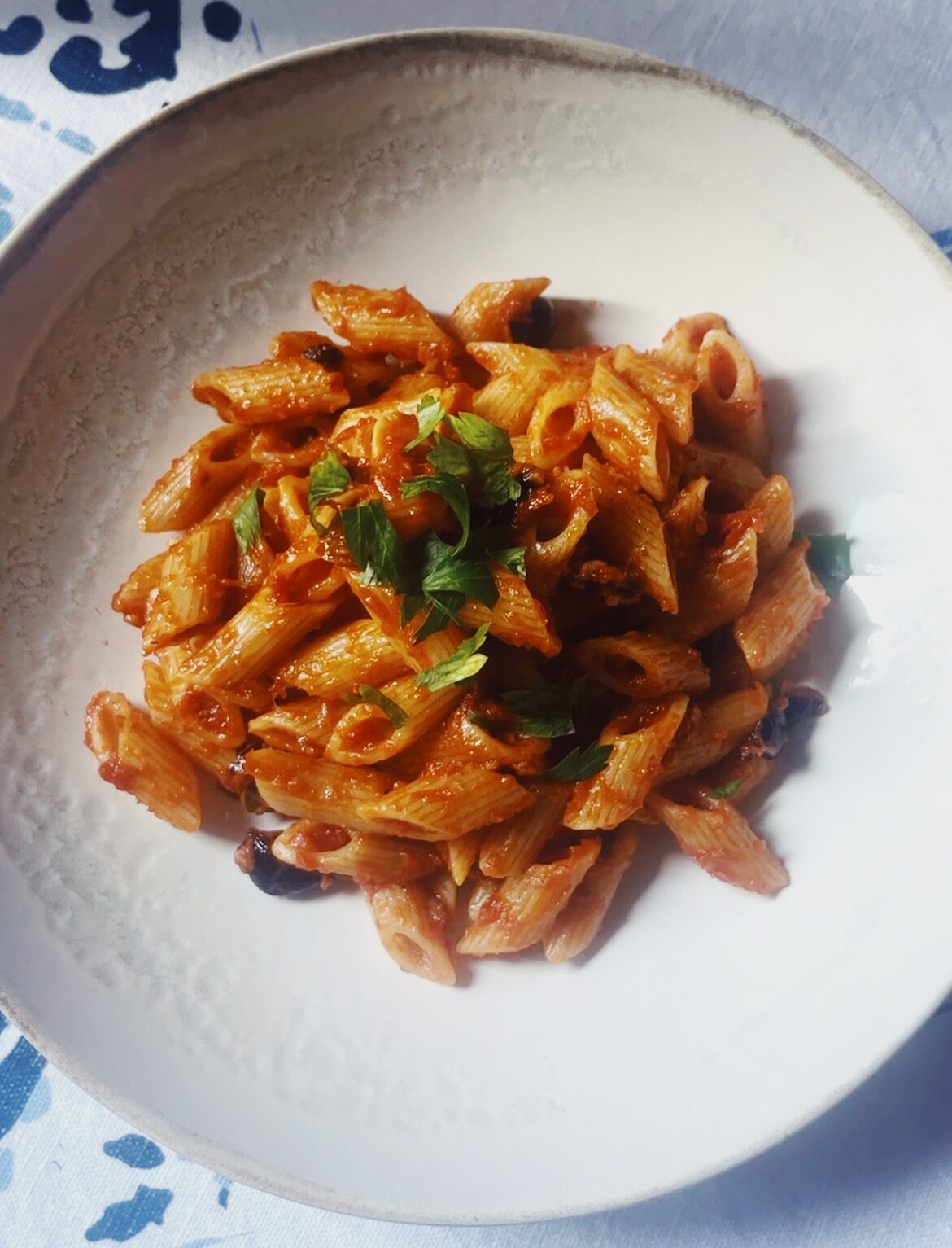
Penne alla Puttanesca, made according to Sophia's recipe
It Started in Naples & Ragù alla Napoletana
In It Started in Naples (1960), Michael Hamilton (Clark Gable), a straight-laced Philadelphia lawyer, travels to Naples to settle his brother’s estate. Upon arriving, he meets his young nephew, Nando, and decides to bring him back to America. But Nando’s lively aunt Lucia (Sophia Loren), a nightclub singer and his primary caregiver, protests, and a heated (in more ways than one) custody battle ensues.
It Started in Naples naturally pairs with Sophia’s ragù alla napoletana since she prepares the dish during one scene. Sophia reveals that Clark Gable was an admirer of ragù alla napoletana, and in the scene, it’s clear no acting was necessary. Sophia, too, sings praises of this dish, calling it the “epitome of pasta sauces”, one steeped in a centuries-old tradition of slow-cooking rich meats and tomatoes until they meld into a flavorful, comforting sauce. She writes, “Today, when the scent of ragù comes into my kitchen in Geneva or Los Angeles, or from my sister’s in Rome, it’s as if the bells are ringing out a feast day as they would when, in my childhood, ragù would arrive on our meager table, managed heroically by my grandparents.”
The word ragù, or “ragoût”, derives from the French verb “ragoûter”, meaning “to stimulate the appetite.” During the reign of the French Bourbons in Naples, this dish began to appear more frequently in kitchens throughout the region, and today, it has become a cherished Sunday ritual in Neapolitan homes. Sophia’s ragù is made with involtini: thin slices of beef rolled around a simple, flavorful stuffing and gently braised in the tomato. The resulting sauce is served atop pasta, and the succulent meat follows as the second course. I adore the ritual of creating this dish, windows flung open to invite in crisp air while the simmering pot envelops the house with an intoxicating aroma. But more importantly, the ragù is an opportunity to bring loved ones together–so it might just have played a part in Michael and Lucia’s happy ending.
Sophia Loren’s Ragù alla Napoletana
Serves 6
INGREDIENTS
- 6 slices beef, each weighing 1/3 pound
- Generous handful of minced Italian parsley
- 6 slices bacon (or as mentioned before, pancetta or guanciale)
- 2 cloves garlic, chopped
- 3 to 4 tablespoons extra virgin olive oil
- 1 cup white wine
- 5 to 6 pounds peeled tomatoes, chopped
- Salt
- Freshly ground black pepper
- 1 1/4 pounds penne, rigatoni, or bucatini
PREPARATION
Pat the meat slices dry and, with a meat pounder or the side of a large chef’s knife or a cleaver, pound them to a thickness of about 1/4 inch. Sprinkle the parsley over the slices. Place a slice of bacon, pancetta, or guanciale on each piece of meat, divide the garlic among them, and season with salt and pepper. Starting from the narrowest end, roll up each slice and secure it closed with a toothpick. Heat the oil over medium heat in a pan just large enough to hold the rolls in one layer. Place the rolls in the oil and brown them gently on all sides. As they brown, moisten the rolls with small amounts of the wine. When the wine is used up and the rolls are golden brown, add the tomatoes, lower the heat, cover the pan, and let the ragù simmer slowly for two hours, or until the meat is fork tender. Turn the rolls from time to time. Adjust the seasoning, adding salt and pepper to taste. The sauce is ready to use. Cook the pasta until just al dente, drain, and ladle the sauce over. Serve while hot. Follow with the meat as a secondo.
Notes:
The sauce can be made several days in advance, and the meat can be saved for another meal.
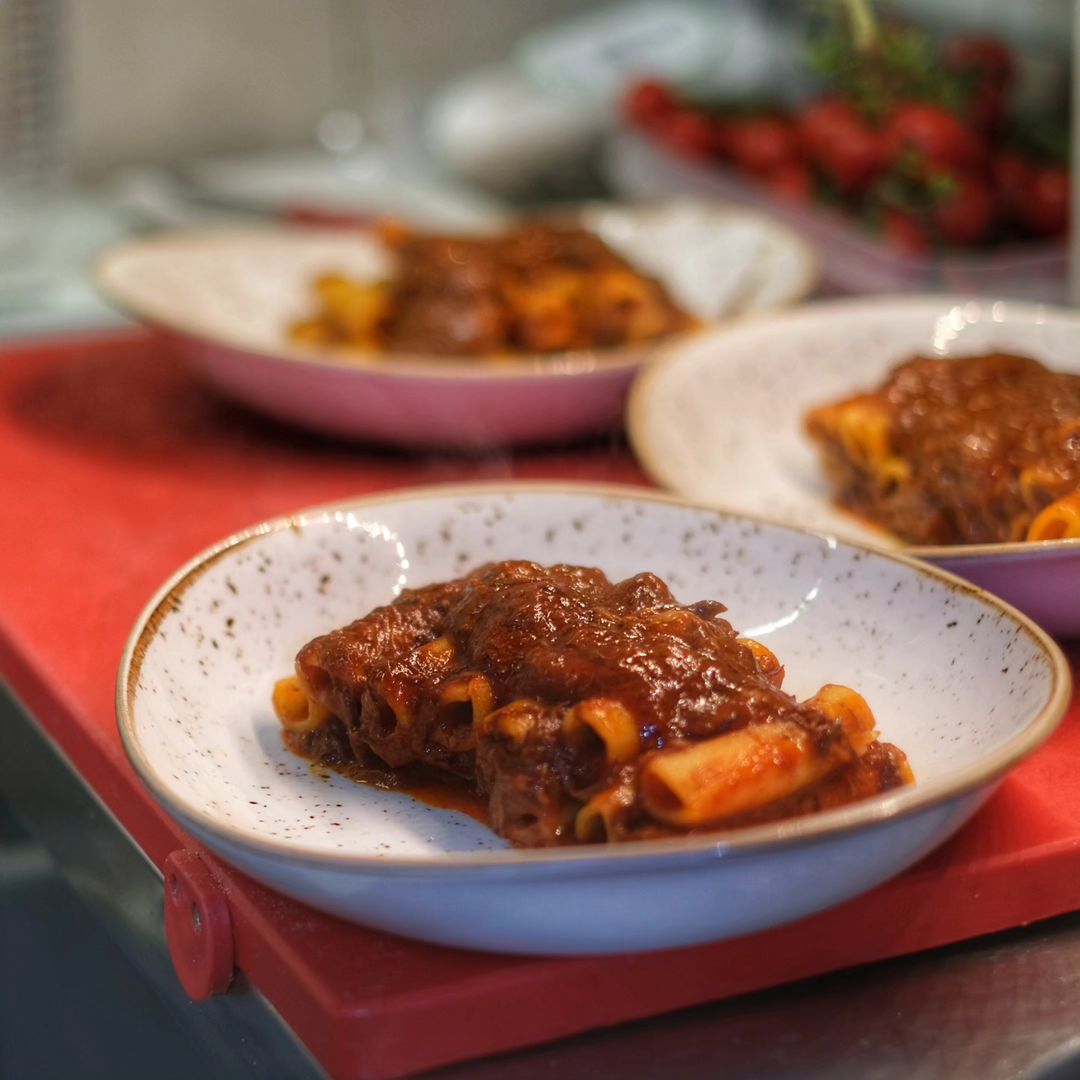
Ragù Napoletano; Courtesy of Salumeria Upnea
Una Giornata Particolare & Fagioli con le Cotiche
Set against the backdrop of Mussolini’s Fascist Italy, Una Giornata Particolare (A Special Day, 1977) brings together two isolated characters: Sophia Loren as a weary housewife and her previous costar Marcello Mastroianni as a persecuted radio broadcaster. When they both stay home from a Hitler rally, their change meeting unfolds into a profound relationship. Directed and co-written by Ettore Scola, the film beautifully explores the real loneliness and oppression that was prevalent at that time, along with the power of human connection that prevailed in the face of such extreme political and social turmoil.
War means being scrappy, and fagioli con le cotiche (beans with pork rind) is certainly a scrappy dish. Plus, it happens to be the favorite of Sophia’s dear friend and costar, Marcello Mastroianni. Sophia wrote, “Why do I bring him up and talk of the cinema when I should be talking of the kitchen? Because I want to remember his most real and everyday side and because I remember his joyous passion for one dish, which for him excelled those on the most refined menus in the world: fagioli con le cotiche. This is a dish for peasants, for the poor, a dish to be found in the most humble eateries. Perhaps that is why Marcello, a simple man, a friend of common people, favored it.”
The rustic quality, bold flavors, and velvety textures are all deepened by the salty, savory pork rind, and I found it to be a classic testament to how Roman frugality can create heartwarming results. And just like Marcello believed, fagiole con le cotiche serves as a reminder that some of life’s richest pleasures come from the simplest of origins.
Sophia Loren’s Fagioli con le Cotiche
Serves 6
INGREDIENTS
- 1 pound of cotiche
- 1 pound dried cannellini or Great Northern beans, soaked overnight and drained
- 1 cooked meaty ham bone
- 1 sprig fresh rosemary
- 1 tablespoon minced ham fat from the bone
- 1 clove garlic, crushed
- 1/2 onion, chopped
- 2 tablespoons minced fresh basil
- 2 tablespoons minced Italian parsley
- 2 pounds canned peeled tomatoes
- Freshly ground black pepper
- Salt
PREPARATION
If necessary, quickly pass the cotiche over a flame to singe off any bristle. Bring a large pot of water to a boil. Add the cotiche, and when the water returns to a boil, lower the heat and simmer for 2 minutes. Drain the cotiche in a colander and refresh under cold water; drain well and place on a cutting board. Refill the pot with water and bring it to a boil. Cut the cotiche into 1-square-inch pieces; add the cotiche and a pinch of salt to the boiling water, lower the heat, and simmer for 1 to 1.5 hours.
Meanwhile, drain the beans and place them in a large pot with the ham bone and rosemary; cover generously with water. Bring to a boil, then lower the heat and simmer until the beans are tender. Drain the cotiche and refresh under cold water. Drain the cooked beans and reserve any meat that has fallen off the ham bone.
Place the ham fat, garlic, onion, basil, and parsley in a deep pot or flame-proof casserole over medium-high heat. Sauté briefly, then add the tomatoes, and salt and pepper to taste; bring to a boil, then lower the heat and simmer for about 20 minutes. Add the cotiche, beans, and ham, and continue to cook for 10 minutes. Serve warm.
Notes:
Depending on your location, you might need to pre-order your cotiche from a butcher or a traditional Italian specialty shop. Hispanic markets frequently stock cotiche as well, and in the south, you can often find it in stores that focus on regional cooking ingredients.
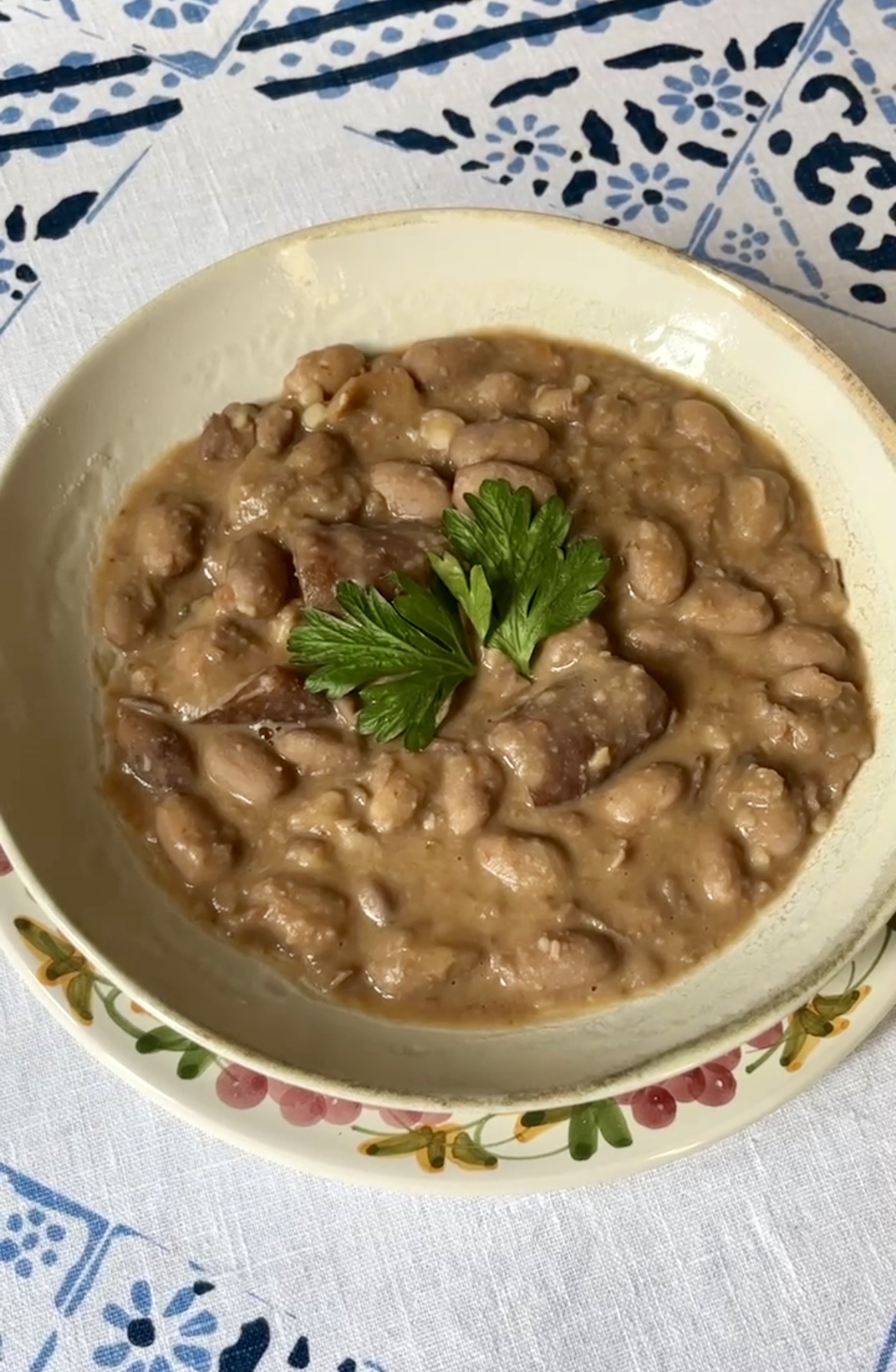
Fagioli con le Cotiche, made according to Sophia's recipe
Fall of the Roman Empire & Eggplant alla Parmigiana
The Fall of the Roman Empire (1964) is an epic historical drama that delves into the decline of the Roman Empire in the 5th century AD. As political corruption and military turmoil erode its stability, General Maximus (Alec Guinness) strives to restore order against the tyrannical Emperor Commodus. Lucilla (Sophia Loren), Commodus’ sister, grapples with her loyalty to her family and the fate of Rome, while Omar Sharif portrays a loyal warrior fighting for justice. The film depicts the tragic consequences of ambition and the collapse of a once-great empire.
On the movie set, the production company provided a daily brown bag lunch for the cast and crew, but the meals were dreadful. One day, Omar turned to Sophia and lamented that he would much rather be enjoying his mother’s eggplant parmesan. Sophia responded that her own mother’s eggplant was, without a doubt, the best in the world.
There’s almost nothing as intense as a “my mom makes a better [insert dish]” rivalry, which led Omar to call his mother in Egypt and suggest she come to Rome for a visit on set–without revealing his secret motive. He proudly showed her around the city, introduced her to his friends, and eventually mentioned, “Next week, we’re having dinner with Sophia and some members of the crew. How about cooking eggplant?” That night, and unbeknownst to Mrs. Sharif, Sophia’s mother was also asked to prepare her renowned eggplant parmigiana. The friendly rivalry between the two mothers resulted in a delightful taste test, with Mrs. Sharif edging out a narrow victory. But Sophia’s mother was pleased, knowing that their culinary contest had blossomed into a beautiful friendship
What I love about Sophia’s (or, her mother’s) eggplant alla parmigiana recipe is how it transforms the humble vegetable into a dish bursting with flavor–it’s not bogged down by stringy mozzarella or oozing with low quality oil, like many you find at restaurants. The preparation brings out the natural sweetness of the eggplant, and frying it without breadcrumbs keeps it light, fresh, and will have you wondering how Omar’s mothers could have been any better.
Sophia Loren’s Eggplant alla Parmigiana
Serves 4
INGREDIENTS
- 4 pounds eggplant
- Salt
- Extra virgin olive oil
- 2 cloves garlic
- 1 pound canned peeled and crushed tomatoes
- Fresh basil leaves
- Freshly ground black pepper
- 1/2 cup Parmigiano Reggiano, grated
- 1 pound fresh mozzarella, cubed
PREPARATION
Cut the eggplant lengthwise into 1/2-inch slices. Layer the slices on a large plate and sprinkle each layer with salt. Place another plate of the same size on top of the pile of eggplant and place a heavy weight, such as a can, on the plate. Set aside to drain for 2 to 3 hours.
Meanwhile, heat about 2 tablespoons of oil in a saucepan over medium heat and add the garlic. When it is lightly browned, add the tomatoes and basil; cook until the sauce is thick, then add salt and pepper to taste. Remove the weight from the eggplant, rinse the slices, and pat them dry. Generously cover the bottom of a large heavy skillet with olive oil and place it over high heat. Add the eggplant slices and brown them on both sides, adjusting the heat and adding oil as needed; you may have to cook the eggplant in more than one batch. Drain the slices on paper towels.
Preheat the oven to 350°F. Lightly coat an oblong (9-by-12-inch) ovenproof dish with tomato sauce. Arrange a layer of eggplant slices over the sauce and sprinkle with the cheeses. Ladle a bit of the sauce over the cheeses, and then continue layering the eggplant slices until all are used up; you should end with sauce on top. Bake for 15 to 20 minutes, to heat through and melt the mozzarella. Serve the eggplant alla parmigiana warm or at room temperature.
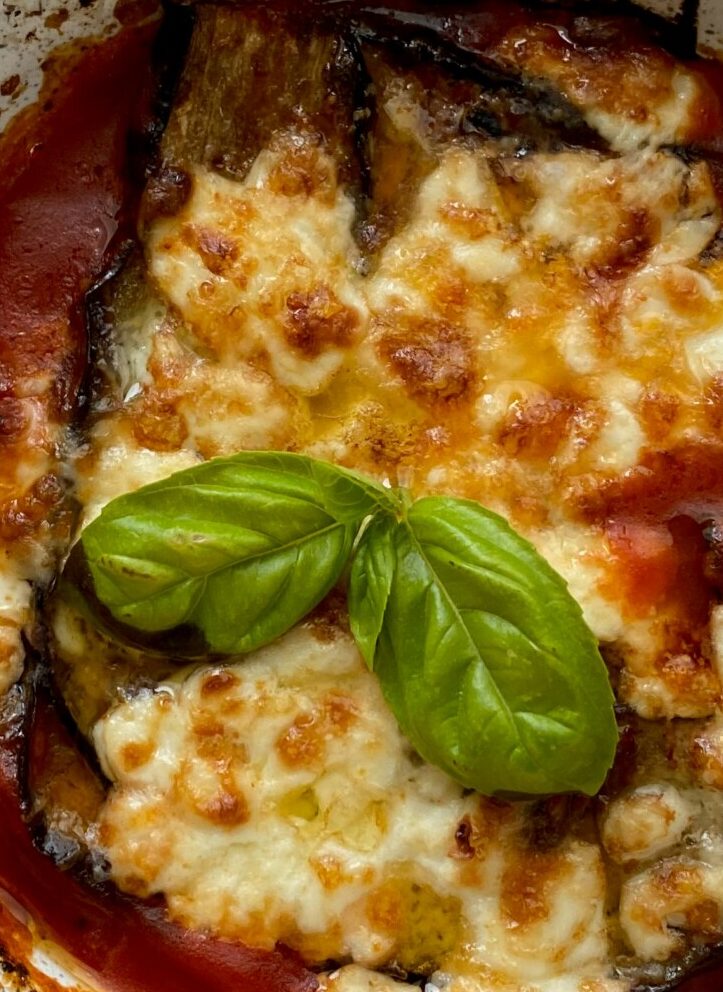
“Don’t be a slave to recipes, to weights, and measures, but let your convictions, and above all, love guide you,” Sophia writes in her cookbook. If there’s one thing I’ve learned from this experience, it’s that cooking, much like acting, is more than just following a script or recipe… So if you’re good at acting, maybe you should try your hand at cooking, and if you’re good at cooking, maybe sign up for an audition or two?

